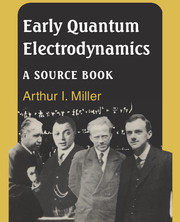Book contents
- Frontmatter
- Contents
- Preface
- Notes to the Preface
- Acknowledgements
- Notes to the Reader
- I Frame-setting essay
- Epilogue
- Notes
- References to the Frame-setting essay
- II Selected papers
- 1 The self-energy of the electron
- 2 Remarks on radiation theory
- 3 Theory of the positron
- 4 Discussion of the infinite distribution of electrons in the theory of the positron
- 5 The self-energy of the electron
- 6 Remarks on the Dirac theory of the positron
- 7 The quantization of the scalar relativistic wave equation
- 8 The electrodynamics of the vacuum based on the quantum theory of the electron
- 9 Theory of the emission of long-wave light quanta
- 10 The universal length appearing in the theory of elementary particles
- 11 The interaction between charged particles and the radiation field
- Index to Frame-setting essay
2 - Remarks on radiation theory
Published online by Cambridge University Press: 05 August 2012
- Frontmatter
- Contents
- Preface
- Notes to the Preface
- Acknowledgements
- Notes to the Reader
- I Frame-setting essay
- Epilogue
- Notes
- References to the Frame-setting essay
- II Selected papers
- 1 The self-energy of the electron
- 2 Remarks on radiation theory
- 3 Theory of the positron
- 4 Discussion of the infinite distribution of electrons in the theory of the positron
- 5 The self-energy of the electron
- 6 Remarks on the Dirac theory of the positron
- 7 The quantization of the scalar relativistic wave equation
- 8 The electrodynamics of the vacuum based on the quantum theory of the electron
- 9 Theory of the emission of long-wave light quanta
- 10 The universal length appearing in the theory of elementary particles
- 11 The interaction between charged particles and the radiation field
- Index to Frame-setting essay
Summary
Annalen der Physik, Ser. 5, 9: 338–46 (1931). Received 25 February 1931.
The Dirac theory of radiation gives a satisfactory account of the absorption, emission, and dispersion of radiation by atoms. Beyond this, quantum electrodynamics also provides a satisfactory treatment of interference phenomena. The results of the theory in most cases agree with what is expected from the correspondence principle, but the calculations which lead to this objective have hitherto been rather complicated, and the simplest consequences of classical radiation theory can only be derived along the circuitous route through a quite nontransparent Schrödinger equation in an infinite-dimensional space.
Below we shall describe a method for treating radiation problems which connects, much more closely than the previous ones, the intuitive conceptions of classical theory with those of wave mechanics and which therefore, in most cases, and without detours, yields the result expected in terms of the correspondence principle.
In this method, the starting point shall not be the Hamiltonian function or the corresponding Schrödinger equation in configuration space but rather the equations of motion, i.e. the Maxwell and Dirac wave equations. These differential equations are integrated explicitly, after the value of the wave functions (E, H, and ψσ) at time t = 0 are regarded as given; here it should be noted that the wave functions at time t = 0 are noncommuting quantities. This noncommutability of the initial values of E, H, and ψσ does not disturb the integration, however, as long as the interaction between matter and radiation is assumed to be small and only linear terms in this interaction are considered.
- Type
- Chapter
- Information
- Early Quantum ElectrodynamicsA Sourcebook, pp. 129 - 135Publisher: Cambridge University PressPrint publication year: 1994



